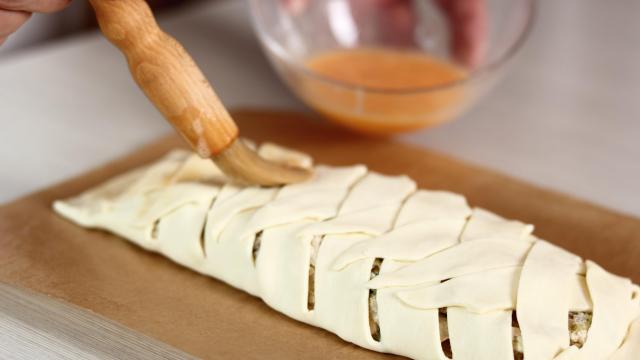Egg wash is a culinary backup singer — you don’t notice it when it’s there, but you sure do notice its absence. Yet there’s always the moment mid-bake when you read ahead in the recipe and grunt, “Ugh, do I have to do the egg wash?” Yep, you kinda do. The egg wash is one of the most important steps in some recipes, and no matter what, they all improve the final product.
A common usage for egg wash is as a finishing coat. You can bet on double-crust pies calling for it, some biscuit recipes call for it, and enriched breads, like brioche, call for a golden swipe, too. For something extra sweet, the sticky surface presents a great opportunity to scatter sugar; the granules will grip to the wash instead of bouncing off. Draping a thin layer of egg over the presenting side of your pastry will also create an irresistible golden brown hue with a charismatic shine. This is due to our cooking MVP, the Maillard reaction, causing the proteins in eggs to brown readily, creating a deeply toasted and shiny coating that is far more tempting than a dry, barely tan, un-egg washed pie. It’s also flavourless in this application because the coating is thinly brushed on leaving no eggy flavour to distract from the dessert. This usage is purely aesthetic, and technically you could skip it if you ran out of eggs, but if you have eggs, don’t you dare leave it off. That’s the equivalent of baking a Funfetti cake but leaving out the sprinkles because you didn’t want to open their packaging.
Egg washing can be purely for looks, but it’s also used as a device to preserve the structural integrity of some desserts without adding flavour. In pies and tarts, this simple application of an egg scrambled with a teaspoon of water can be the difference between bakery-perfect pastry and acrid smoke billowing out of your oven.
For a double-crust pie, the egg wash should be added around the top edge. Once the filling has been piled in, the top crust will meet the egg washed edge and create a seal of the utmost importance. The top and bottom crust are glued together by the egg and, since the proteins in eggs coagulate and cook at 158°F, they’ll seal up the pie’s seams far earlier than when the pie filling starts to expand and bubble at 212°F (when water boils and evaporates). This keeps all the pie filling inside the pie where it’s supposed to be, instead of bursting out of the edges and burning onto the floor of the oven.
For tarts and pies that will have a no-bake filling or an especially thin, liquidy filling before baking, like a lemon curd tart or a pumpkin pie, some recipes recommend an egg wash applied to the bottom crust to prevent leakage. This egg wash application is meant to be unseen so using the right egg wash can make a difference. In this case, scrambled egg white is just fine because a dark golden brown colour won’t be appreciated under the filling. To do this, blind bake the pie or tart crust as needed for the recipe. Once the crust is out of the oven and the pie weights are removed, brush the egg white wash all along the inside bottom and inner edges while it’s still piping hot. This fills all the pores and fine cracks with egg, and the residual heat of the crust is still around or above 158°F (but not consistent enough to trigger the browning of the Maillard reaction), cooking the egg after you brush to make a seal. Pour in a custard or layer in a banoffee filling, and thanks to the egg wash, there’s little risk of your crust getting a Paul Hollywood-level soggy bottom.
It doesn’t take much — a thin coating is all you need for both sealing and finishing applications (if you overdo it, the egg will puddle and cook as a small scrambled egg). One egg goes a long way, so prepare yourself by checking ahead in recipes to see if you have enough eggs on standby. When your oven reveals a glamour-shot-worthy pastry you’ll thank your past self for being such a go-getter.

Leave a Reply
You must be logged in to post a comment.